Extra Questions for Class 9 Science Chapter 6 Tissues
Extra questions for Class 9 Science Chapter 6 Tissues with answers is given below. Our subject expert prepared these solutions as per the latest NCERT textbook. These questions will be helpful to revise the all topics and concepts. CBSE Class 9 extra questions are the most simple and conceptual questions that are prepared by subject experts for the students to study well for the final exams. By solving these extra questions, students can be very efficient in their exam preparations.
Tissues Class 9 Science Extra Questions and Answers
Very Short Answer Questions
1: Name the tissues responsible for the movement of the body.
Answer: Muscle tissue and nervous tissue
2: How does neuron look like?
Answer: A neuron is the unit cell of nervous tissue. It is a thread-like structure with cell body and axon.
3: Name the types of simple tissues.
Answer: (a) Parenchyma
(b) Collenchyma
(c) Sclerenchyma
4: Name the types of complex tissues.
Answer: Xylem and phloem.
5: Where is apical meristem found? .
Answer: It is present at the growing tips of stem and root, it increases the length of the stem and roots.
6: Which tissue make up the husk of coconut?
Answer: Sclerenchyma.
7: What are the constituents of phloem?
Answer: Phloem constitutes the sieve tubes, companion cell, phloem parenchyma and phloem fibres.
8: Define aerenchyma.
Answer: When the cells have air-filled large cavities of parenchyma, it is called aerenchyma. Aerenchyma helps aquatic plants in floating.
9: What is the utility of tissues in multicellular organisms?
Answer: It helps in growth, organisation of different organs and performing functions.
10: Name the two types of tissues.
Answer: Plant tissues and animal tissues.
11: Name the two types of plant tissue.
Answer: Meristematic tissue and permanent tissue.
12: What is differentiation?
Answer: The process of taking up a permanent shape, size and function by cells is called differentiation.
13: Name the three types of meristematic tissues.
Answer: The three types are:
(a) Apical tissue—tips of root and shoot
(b) Lateral tissue—sides of stem
(c) Intercalary tissue—at nodes
14: Where is apical tissue found?
Answer: Present at the tips of roots and stems.
15: Tissues present at the lateral surface of the stem are called apical tissues. Put (T) if true and put (F) if false.
Rewrite the answer if (F).
Answer: (F). Tissues present at the lateral surface of the stem are called lateral tissue.
16: Which tissues are present at the nodes of the plants?
Answer: Intercalary tissue.
17: What are the various types of blood cells?
Answer: There are three types:
(a) RBC’s
(b) WBC’s and
(c) Platelets.
18: What are tracheids?
Answer: They are elongated cells with tapering ends.
19: What are guard cells?
Answer: Each stomata is bounded by a pair of specialised kidney-shaped epidermal cells called guard cells.
20: Epithelial tissue is the simplest tissue. Write (F) for false or (T) for true.
Answer: (T).
21: What are the functions of cuboidal epithelium?
Answer: It helps in absorption, excretion, secretion, it also provides mechanical support.
Short Answer Type Questions
1: Give four differences between bone and cartilage.
Answer:
| Bone | Cartilage |
| Hard and non-flexible | Flexible not very hard |
| Porous | Non-Porous |
| Blood vessels present | Blood vessels absent |
| Matrix made up of protein and mineral salts. | Matrix made up of proteins. |
2: Give the functions of bone.
Answer: The functions of bone are:
(i) It provides shape to the body.
(ii) It provides skeletal support to the body.
(iii) It anchors the muscles.
(iv) It protects the vital body organs like brain, lungs, etc.
3: Give the functions of cartilage. .
Answer: (i) It provides support and flexibility to the body parts.
(ii) It smoothens surface at joints.
4: Fill in the blanks:
(i) Water and minerals are conducted by _________
(ii) In higher plants food is conducted by _________
(iii) Blood is a __________ tissue.
(iv) Bone consists of __________ cells.
(v) Cartilage consists of __________ cells.
(vi) Fibres are absent in __________ type of connective tissue.
Answer: (i) Xylem
(ii) Phloem
(iii) Connective
(iv) Osteocyte
(v) Chondrocyte
(vi) Blood
5: What are the functions of areolar tissue?
Answer: Functions are:
(i) It helps in repair of tissues after an injury.
(ii) It also helps in combating foreign toxins.
(iii) It fixes skin to underlying muscles.
6: Give difference between xylem and phloem.
Answer:
| Xylem | Phloem |
| It consists of mainly dead elements. | It consists of mainly living elements. |
| It conducts water and minerals. | It conducts food. |
| It provides mechanical strength to the plant. | It does not provide mechanical strenght to the plant. |
7: What are fibres?
Answer: Fibres consist of very long, narrow and thick cells. Example, jute fibre.
8: Name the tissues for the following:
(a) Stores fat in animal body.
(b) Divides and re-divides to grow in plants.
(c) Tissue that joins hone to hone.
(d) Covers the external surface of animal body.
Answer: (a) Adipose tissue
(b) Meristematic tissue .
(c) Ligament
(d) Epithelial tissue.
9: What is stomata?
Answer: Stomata are small pores present on the surface of a leaf which helps in the exchange of gases and in transpiration.
10: Why does epidermal tissue have no intercellular space?
Answer: The epidermal (layer) tissue forms a protective outer covering for the plants and it protects the internal parts of the plant. It aid in the protection against loss of water, mechanical injury and invasion by parasitic fungi.
For this protective role to play the continuation of cells is necessary, hence it does not have intercellular space.
11: Name and give the function of each cell of xylem:
Answer: Xylem consists of tracheids, vessels, xylem parenchyma and xylem fibres.
Tracheids and vessels—Allows the transport of water and minerals.
Xylem parenchyma—Stores food and helps in the sideways conduction of water.
Xylem fibres—Are supportive in function.
12: What is the function and location of stratified squamous epithelium?
Answer: Stratified squamous epithelium is present in the skin. The layers of cells are arranged to prevent wear and tear.
13: Give difference between ligament and tendon.
Answer:
| Ligament | Tendon |
| Ligament helps in connecting bone to bone. | Tendon helps in connecting bone to muscles. |
| It is elastic and flexible. | It is strong and non-flexible. |
14: Give difference between striated muscles and unstriated muscles.
Answer:
| Striated Muscles | Unstriated Muscles |
| They are skeletal muscles. | They are smooth muscles. |
| They show alternate light and dark bands. | These muscles do not show such bands. |
| Voluntary muscles. | Involuntary muscle. |
| Cells are cylindrical, multinucleated | Cells are tapering, uninucleated. |
15: State the difference between bone and blood.
Answer:
| Bone | Blood |
| It is a hard tissue. | It is a liquid tissue. |
| It consists of osteocytes. | It consists of plasma, RBC, WBC and blood platelets. |
| It helps in movement and support of the body. | It helps in the transport of substances. |
16: Name all different types of tissues present in animal.
Answer: There are four main types of tissues present in animal. ‘
(a) Epithelial tissue present on the outer and inner lining of the body.
(b) Muscular tissue are made up of muscles, help in movement.
(c) Connective tissue connects the different organs in the body.
(d) Nervous tissue consists of nerve cells and are present in the nervous system.
17: Why is blood called connective tissue?
Answer: The blood is composed of cells and plasma. Plasma is a fluid and cells like red blood cells, white blood cells and platelets are present in it. All these cells are connected due to plasma. It also transports food, water to different parts of the body and connects them.
18: Name three types of muscle tissues and give function of each.
Answer: Three types of muscle tissues are:
(a) Striated muscle (b) Smooth muscle (c) Cardiac muscle
(a) Striated muscle: These muscles show alternate light and dark bands or striations. They are involuntary and present in skeletal tissues, help in movement of body and bones.
(b) Smooth muscle: These are involuntary muscles, control the movement of food in alimentary canal, contraction and relaxation of blood vessels. Present in iris, uterus etc.
(c) Cardiac muscle: These muscles are present in heart, help in the rhythmic contraction and relaxation throughout the life.
19: State the difference between simple tissues of plants.
Answer: The simple tissues of plants are:
(i) Parenchyma (v) Collenchyma (iii) Sclerenchyma
| Parenchyma | Collenchyma | Sclerenchyma |
| The cells are living and thin walled | The cells are living and thick at corners. | The cells are dead and thick walled due to lignin deposition. |
| The cells are oval, spherical or polygonal in shape. | The cells are elongated and thickened at corners. | The cells are long and narrow |
| There is large, intercellular space between the cells. | There is very little intercellular space. | There is no intercellular space. |
20: With the help of diagram show the difference between striated muscle fibre, smooth muscle fibre and cardiac muscle fibre.
Answer:
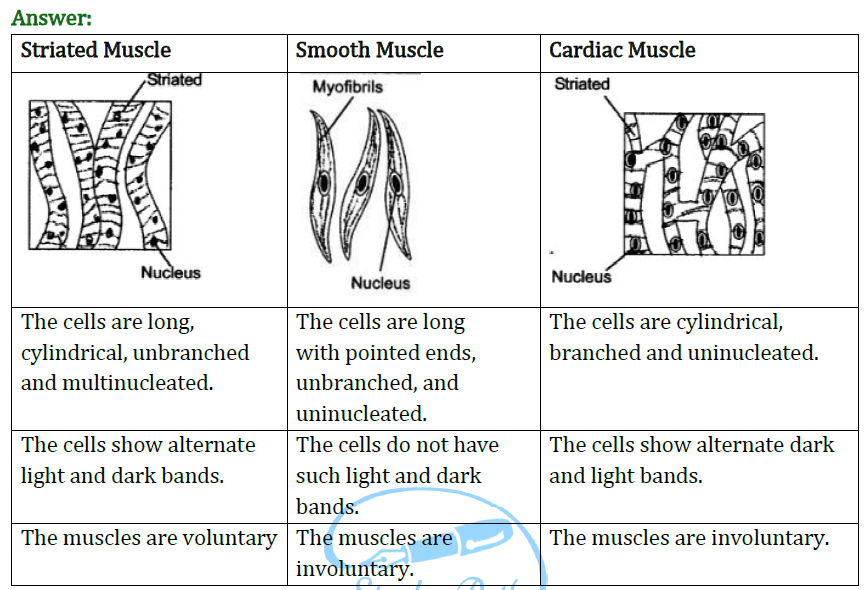
21: Name different types of meristematic tissue and draw diagram to show their location.
Answer: The 3 different types of meristematic tissue are:
(a) Apical meristem—Function: growth in length.
(b) Lateral meristem—Function: growth in thickness.
(c) Intercalary meristem—Function: growth in internodes.
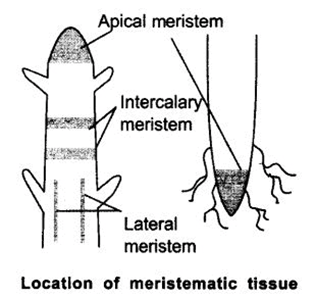
22: Explain the structure, function and location of nervous tissue.
Answer: Structure: Nervous tissue consists of cells called nerve cells joined end to end (neurons). A neuron (nerve cell) consists of a cell body with nucleus and cytoplasm. From these cell body a long thin hair-like parts arise called axon and many short branched parts called dendrites.
Location: Nervous tissue are present in brain, spinal cord and nerves. Function: Nervous tissue receives the stimuli and transmit the stimulus rapidly from one place to another within the body. The nerve impulse allows us to move our muscles and respond to any stimuli.
23: Give the flow chart of plant tissues.
Answer:
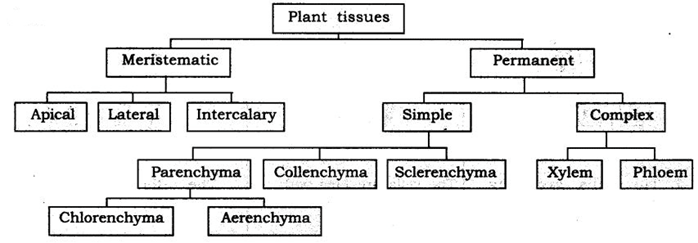
Long Answer Type Questions
1: Write a note on plant tissues.
Answer: Plant tissues consist of two main types of tissue.
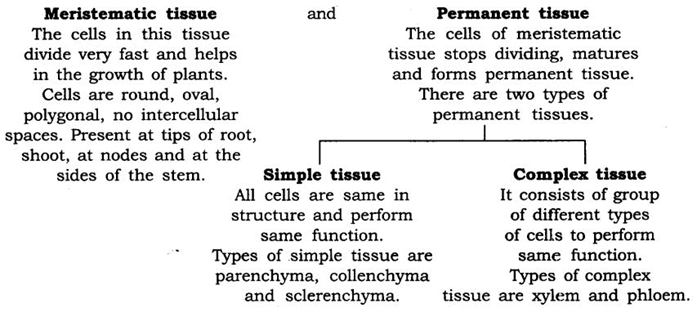
Parenchyma: Present in soft parts of the plant.
Collenchyma: Provides mechanical support to plant present in stalks. Sclerenchyma: They provide strength and flexibility to the plants.
Xylem: Conduct water in plants from root to shoot. Consists of tracheids, vessels, xylem parenchyma and xylem fibres.
Phloem: Conduct food to all parts of plant. Consist of sieve tubes, companion cell, phloem parenchyma and phloem fibres.
2: Show the types of animal tissues using flow chart.
Answer:
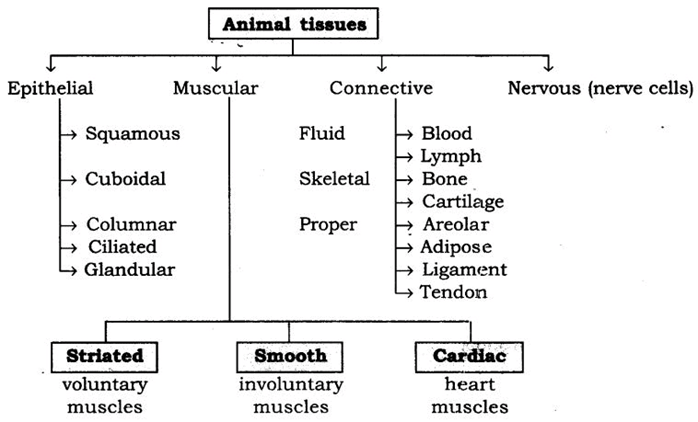
3: What is connective tissue? Explain its types.
Answer: The connective tissue consists of different types of cells, all of them perform same function.

Areolar connective tissue: It is found between the skin and muscles, around blood vessels and nerves and in the bone marrow. Areolar tissue fills the space inside the organs. It supports internal organs and helps in repair of tissues.
Adipose tissue: Adipose tissue stores fat, found below the skin and between internal organs. The cells of this tissue are filled with fat globules. It acts as insulator due to fat storage.
Blood: It has a fluid called plasma, in plasma are present red blood cells, white blood cells and platelets. Blood flows all over the body and helps in the transport of gases, digested food, hormones and waste material to different parts of the body.
Lymph: Lymph carries digested fat and lot of white blood cells in the plasma. Bone: It forms the framework that supports the body. It supports the different parts of our body. It is strong and non-flexible tissue.
Cartilage: It is present in nose, ear, trachea and larynx. It smoothens bone surfaces at joints.
Tendon: It connects bone and muscles. These tissues are fibrous, flexible and with lot of strength.
Ligament: It connects bone to ‘bone. It is elastic, has lot of strength.
4: Describe ‘epidermis’ in plants.
Answer: Epidermis forms the entire outermost layer of the plant. It is made up of single cell layer. It protects all the internal parts of the plant. On aerial parts, epidermis secretes waxy, water-resistant layer on their outer surface. This helps in protection against loss of water, mechanical injury and invasion of parasitic fungi.
In leaves, epidermis consists of small pores called stomata. These pores help in the transpiration and exchange of gases, like oxygen and carbon dioxide for plants. In roots, epidermis have long hair-like parts that provide greater surface for water absorption. In desert plants, epidermis has a thick waxy coating of cutting which acts as a water proofing agent.
5: Explain the “complex tissue” of plants.
Answer: Complex tissues are made up of more than one type of cells. All these cells co-ordinate to perform common function. These are—xylem and phloem. Both are conducting tissues and form a vascular bundle.
Xylem consists of—tracheids, vessels, xylem parenchyma and xylem fibres. Most of these cells are dead. Tracheids and vessels helps in water transportation, parenchyma stores food and helps in the sideways conduction of water and fibres are mainly supportive in function.
Phloem is made up of four types of elements—sieve tubes, companion cells, phloem fibres and phloem parenchyma. It helps in the transportation of food in both the directions, i.e. from leaves to roots and to other parts of the plant.
Value Based Questions
1: A group of students completed the project of finding the botanical names of all the trees present in the school campus. They prepared metal plates with names carved on it, to fix it on the plant trunks. Shreya was concerned that if the metal plate is fixed into tree many cells of the tree may get damaged. But the group members explained her that the outer layer of trunk does not have living cells and there won’t be any damage to the tree.
(a) What type of cells are present on the outer layer of the bark/tree trunk?
(b) How does the cork act as a protective tissue?
(c) What value of the group is seen in the above cast?
Answer: (a) On the outer layer of the tree trunk/bark all thick layer of dead cells is present which acts as protective tissue.
(b) In cork, all cells are dead without intercellular spaces, the walls of the cells have deposition of suberin.
(c) The students in a group show team effort, peer learning and cooperative.
2: A paralytic patient was unable to walk. ‘The family member of the patient took the outmost care of the patient.
(a) Name two tissues responsible for the movement of a body.
(b) Name the tissues present in brain and spine.
(c) What value of the family members is seen in the above case?
Answer: (a) The two tissues responsible for movement of the body are muscular tissue and nervous tissue.
(b) The tissues present in brain and spine are nervous tissues.
(c) The family members showed the value of being caring, responsible, dutiful and kind.